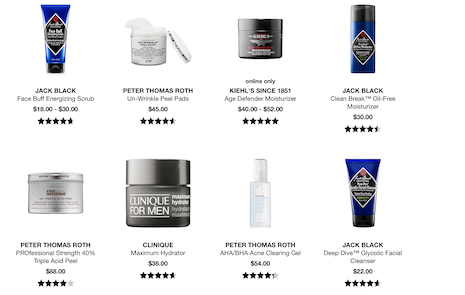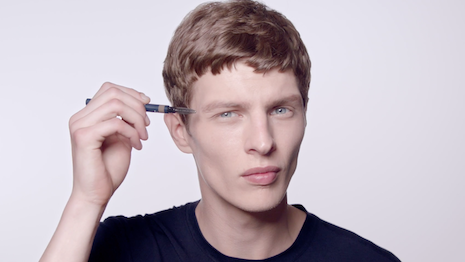Luxury cosmetics labels are beginning to pay more attention to male consumers, as sales of men’s grooming products continue to grow.
According to Euromonitor's 2018 Beauty Survey, sales of men's grooming products neared $50 billion in 2017 and are on track to grow 16 percent to 2020. As brands develop and market personal care and beauty products for men, they are using more gender-neutral strategies, reflecting changing attitudes surrounding gender norms among today's consumers.
"The visual images of what is male or female are being rethought, and especially Gen Z isn't as strict as millennials and baby boomers as to what that looks like," said Andre' Barnwell, instructor at the Fashion Institute of Design & Merchandising, Los Angeles. "Social media has made men and women more conscious of the 'perfect' look.
"The well-groomed man takes care of himself and is not ashamed of paying more for it," he said.
Rethinking male grooming
Traditionally, the men's grooming market was dominated by shaving and hair products. For instance, Euromonitor found that 40 percent of men use shampoo on a daily basis.
However, surveys by Mintel have found that interest in facial skincare and anti-aging products among men is on the rise.
In one Mintel survey of American men who use personal care products, 70 percent said they used sunscreen and other sun protection products. Eighty-four percent of men between 18 and 44 also said they use facial skincare products, such as moisturizers.
In the United Kingdom, Mintel found that 15 percent of men under 45 purchased cosmetic products in 2016, though it was unclear how many of these purchases were for personal use.
"The growth of men's beauty and fashion products has been outpacing those of women's since 2010," said Romey Louangvilay, communications director at ELMNTL, New York. "It goes to show that regardless of gender, people want to feel confident in how they look."

Sephora cares a wide range of skincare products for men. Image credit: Sephora
On an average day, American men use 4.1 beauty products and while French men average 2.8 products, per Euromonitor.
According to Fashionbi, luxury brands are hoping to capitalize as more men purchase cosmetics for their own use, a trend that first found popularity in Asia (see story).
Men between the ages of 18 and 26 are also primarily responsible for the rapid growth of the Chinese cosmetics industry, the South China Morning Post reported in 2017.
"Male beauty lines are still proliferating today because several well-established brands realize that without such products or services, they risk losing their existing customers to competing brands that already offer a beauty line," said Thomaï Serdari, brand strategist and professor of luxury marketing at New York University and coeditor of "Luxury: History Culture Consumption," New York. "From a consumer's point of view, the loyalty consumers show to specific luxury brands attests to the fact that they would ideally like to have their life designed by the brand."
Before debuting on ecommerce, the new Boy de Chanel makeup line was launched in South Korea. Reflecting the more minimalist tendencies of male makeup consumers, Boy de Chanel cosmetics includes four products: a sheer coverage foundation, an eyebrow pencil and a matte lip balm (see story).
Chanel is also marketing gender-neutral skincare products on its Boy de Chanel landing page, including cleansing cream, serum and sunscreen. The line's midnight blue packaging is minimalistic without being overtly masculine (see story).
"In general, men want products that are multifunctional because they invest less time in thinking about solutions to a variety of questions of appearance," Ms. Serdari said.

Chanel shared beauty tutorials aimed for men. Image credit: Chanel
Influencers and tutorials play a major role in the popularity of cosmetics for men, in Asia and beyond.
"Since more people are sharing their own makeup tips, it's slowly making it more acceptable for men to wear makeup without being ashamed – just look at the Kpop stars in Korea," Mr. Louangvilay said. "Due to social media, others can connect with like-minded people and share their experiences."
A report from Traackr reveals that in the first half of 2018, Estée Lauder Cos.' La Mer has seen the most engagement of any other mass or luxury skincare brand thanks to its partnerships with numerous social influencers (see story).
Crème de la Mer created a series of content for the audience of Mr Porter to gain visibility for its men’s skincare line.
Mr Porter shared journal entries that detail the routines of personalities such as New York maître d’ Alireza Niroomand, in which the men use La Mer skincare. Hoping to inspire viewers and readers to introduce La Mer into their routine, Mr. Niroomand describes why he likes each product (see story).
Similarly, U.S. label Tom Ford is sharing its namesake founder’s dressing regimen and philosophy with a social video for its new men’s grooming collection that inspires consumers to achieve the same branded look.
The video briefly describes the products included in the collection before Mr. Ford gives tips for men wanting to look their best. Having the video narrated by Mr. Ford, rather than a model or celebrity ambassador, makes the connection fostered by the video more authentic (see story).
"Male beauty products have to be performance-driven as well as cosmetic-driven," FIDM's Mr. Barnwell said. "Male beauty products have to be considered important to the overall lifestyle of the man.
"Luxury brands have to tie this 'look' to their luxury lifestyle, and again luxury male ambassadors are key," he said.
Beauty barriers?
Fragrances are one category that have long been marketed towards men and have been popular among male celebrity ambassadors as well.
As with fashion, fragrances are becoming increasingly genderless to allow consumers to select scents that speak to their personalities rather than their genders. For this reason, unisex fragrances have also been trending.
Les Mirages, four newer additions to Prada Olfactories, are all unisex in design.
Scents include Soleil au Zentih, a spiced fragrance, and an oud rose named Miracle of the Rose. The series includes Darklight, an amber scent and Midnight Train, a patchouli fragrance (see story).
Personal care group Coty Inc. works with a variety of high-end brands to create fragrances that appeal to the modern world, hoping diversity will be universal in the near future.
At the Condé Nast International Luxury Conference on April 19 the chief marketing officer for the group's luxury division expressed her desire to have complete inclusion in beauty. Themes such as genderless campaigns and products for a wider range of skins tones are just a few of the ways Coty is integrating diversity into its business, hoping it will foster growth in the industry (see story).
"Brands need to realize gender norms are blurring and you have to evolve with society," ELMNTL's Mr. Louangvilay said.
{"ct":"xJBWlVV308Na5A5MJYEKvt6eGMkrYmXSmNrid5QOEh0WNCYgbX0vpCmDVNQ6jdv+k6Sn8V8V7qpSJFWLXmK7cDTr3NAmDj6PYjCCZcvTwmWMM\/m2B4g0F\/rXbIDTkTiyu5d42FVgxBxqUOuqWwZKO9aqoE2s2dL44QEQg\/z1IymWYCPycjBMyQS\/AS\/uABM\/uMlccXXGALcJy+CvJkoSbQHYSc92T70qwxzCmaZBk0qlU5G3\/jL97k8sV\/Cu1i\/IZa8XEop0K76T71Wn0VebwCMb2a7YhHMkGe9ZfQZtSHqGfLghMv\/rlPiz9tlhP4FfOMSpJLfTCOgNVrN+C1cK3FLCqnVQrMkDnAGEuohmOIazB+L3OQ541fZkpqABPCwOSVSr1iwyZjV2DqWzvgsFS1r3hfO8t91M\/p35h6gluatvorsfCEhomHJ2eC333zfmz1ATFejKVkImcv3nyMqSkZUg1xVTuKSAkKJlrB+R2sAYQt663LvLW0nIu\/onEhp+\/X+W2AnhVKDZdhN3o+07EYXyGvUpItodqbLEkM\/xRKfZGEOTCUe9Vik6eccUCenIpBVSnzGhzegT8b18kjHSmidkN5N\/Lqov11FAOXDauvCApbopA45WQ9TWJ+dzr7yKadHvpvtoeWTW+FT44yvr48er0EbNCRoswP9GPDoPKn4763z6Wl7dqNDXkmHwqimXELX+i5KVT7LaTNWc05ztj4sQ2jVl\/vI3ibm\/tLjXwGbEwq2DfMUHjBQXIUg71ls0etJYco5txmATJtuJu29Ms38QOS7NARQTK6cVteaVTePGOtpoQAaI5+4Qy2YM7enD2jcQG8JVkOgdDDDRhdRNP8uQDnUXwFkqzvT1sQpxurfJtQDB1op9383Im\/URGRJTpyavb6hMxiLxvsua3fiuUj+uC8N1YfEjZQz7bHq3QJvfxgTobhTFQt9026FVb8GxxI1ZIjr24R03kJ55EaZtqWfk76rJUvP\/PHKQty\/0yMGWi7zJBXwMZ97vpALJ8jnqhAlG\/RPpu0mPayU2AWxbOxjSfYxuo3sodT74th+U1M5e8\/hkbMzvlIWAdC2CGIA1AXCPoEAdR5ZHtuq2vX0S29\/XD5rPvwqgZ9vkjQONVYr6CFtzJTq2Xc8iEmku7ebyWsXKgAfVmPV36a2xRDXYxHG5PuL9JskGWT6yEkTwgBw6v5xOU6EvMN11q8gvQ4JIdTVbxYUdHYPS86lCBd9mhytfBKaHDU52medbqRAiglB\/HNW0XFm0sU6TceLb9ss5YfQZOXHlro8AJVO4aaGoCWTxWQRE1lbQunCZfh79KaWNCaNTO+wiIqeiEM62l6y5NQEn1qrL7nRdksvP4Ah7um1nCLS2Uh0IAB1sHa6pODU\/ZqXtl7xEWUpKDxdw8et5Gi8vQ+TLtFrOi4P7jqfWMdivef+SBqAE5J6UmbF80DUGERykoEyoD89HQAoVLXhn3JTtSOkkrHFsgt0TMfRTomdQ3fyjxrzBZkE21Dp9wiG7jodwn\/KgSlRNG4Upq+Z1SAzj8l+SEnr8byozDt4wWhVrJFiGppJfeLT2arXf+cZ1WJDSy28qfNWaMrgIe+Tqp5iFp8Tr5NaLzHmhjFzksJcF+BeYEkqvBpFiDhqomaVUbIyIEEmT50ICdUgAYU7jnK26HGWNXKzPjmJH4E4i+5e44icJSaPpuL8laX3sFnejss0bfcCtAxMIltoESmq+1YqjbiOS0Pkzn3DobtqwgHnJZ4ThbZi0j\/JvJYppl\/HquT1b5FGiTV6tfoeJdT\/pN39YO1hA3mgHu+j4ZtN2GdZVR8BDOI6IhtotTfxeUrk\/i0PgK0+6VpaDak4pwD8D0x6R\/PDKSr5FRWd3fRzefHbKXBL4rGcP67BFBlfADb7zvaoOHlJM0+8Mp0dOXseIifWlSfVIB8WZfT4T439fW+062EWu6QhMlFHmYkvLS4DhkSBSrvbH52VY6988jOv5EOiPFZ1VFZR6yjMxRzM0505ujSGgi2LLxwCLUcKY2nUI7TWJZIIDEkf\/6CK4ppYovJjhfOtWhzR4gDySFBltl585nriRvrsmpSGwjeTUp90Wvi6Uy6umBToGSpHwOY09cyAqwTOZx9\/P\/kstwhzFuXxb1S3VsBagUW\/xHOYj3tJt3O55hOxhtjUQfARyAtV+hd4m1lkz\/jaFMMNgP4IqCiNC0nhvVMSTehSMpEZqrVIcNn5JHq3zByJS+Tudyea5Wb84U71kHG+L2fpw+ni2+uXtqblUzm6O97vwMcRUdZ+cACISc6qIDATaAO8yArhi5zempWy5fmpxJG6Xq+1pgOhcZ1g6OULWCfTTADiZAX\/fFtfj2XqwoJc\/2FrIagdpvQVFaAUPGfTU1DP3RoRNoffz0RaPYL4heUyx78rrbFkZ+B5HNuqzw3DUVUdW54dyIYGTRukWbTNYJje7kcu8klAW7skWPZmwK4YJCZwLcUxPuP6k9d\/CAucGQzTRI59HfS7BGQD+j6QYMomcdWoVWl\/ktVaxYuy+LipeLRfEJk+KzopvkjQ3JPQErEjkrdot9aSPSjAMdFsP6MafPiWcxjj8ba7z7ocCuTjoeD4zmeXBQ0EQ9bGWFB9PNfq6jkn0mFRvIRAmvWT4SiUiOVqyVN239N2fd8aLnSnJQC28Q+BPDhk+toEr+f8xahFibY61THZ3Oi+G8qdkqQT7fuxaGn7B6YrsWC0zu7KQfsTSnVyaqyw0IlFokXVIX7A5t9CUOwS9run+NgTo0jFj0qWCO6DllKSz9h8hutmMY9Z1978AnTt0VOeBnsgDnnxr0wcnCJCj87aoPZcW9V5WCCwfj4dBd8T9rS8gIkmWpaJWuiD7Ft9Zu8rMja6mtewwbJuTDOZyxUmWjwRSV+bZkT+SjNgmujZuRJ6tgtOrdH5HuoGrWjJutNq8aQqInITzHNoxdubBZxeKZLfktzIRjEUe+yix1pcfryluDgjCb3Ejno9TyGkzVEwnc4MKIJFI9jEfvJSURebs0Xh52AAsxpVKzUQmNmZXeGyGtBemtJvrUV0KcakiZ+A92rgzu82PLTjLgFtdRKGlhgnWkQn5tEkQ49nHWK9\/mEyGHnOIirs\/BzZhVNKUSlrY1b+7afG1Oegkl9diIuxyXr6698hhgaqgPHBhG0De7KTBebSR2ioljxLV6txrKfmQSB07\/7Q93qCbY3qrCOZRLSgjEcuJoHb7PTHN6j3xVGgpxSz1CTuxksU8QBAKwfuFb7wuSA2Wo+Dhkm2UnNbUVIr1m\/aTO56Rd6H7UpcdhoHFONVFK0EsI2V46RKUxlMkJPgTHoyr8PppbOlbTR\/yrjg9hTe9vGQmLJKJolFne6pqZyGH7zsPkipbfzQ1wkoCNWwayJjsk+Gq7hwnTJuCTJAber05XozvV74J+O5qU3Zykaju+olOAZkCRflQIFG4qBSRGGJBntCKFsnF7taa6yRvXJt3KbVC7LFp9dJyacvBjpTGol75CzDU5Hz5ESyTQWmsOCSQJJoLc47DwcXJ6XUtb8PIPTpn1wsN1xcn3uj5JDIIWbjrbXT\/4q9NXKYQi71RUj3v4wFF5Endd9SfBcykj1eTYvBEiPHgo9SsqkjK0cvsBhsRfL6TbD8zX1o60Ew2QNze6Zw52bQK\/uT+7X6zKP97AhE3tjQOG4oXn1MTj1IBND3kEjn4Sqy1p7J0pgwTo5j0+yjNpaIF58Y2FFEVVaHzmfMUO4kYtrb0X\/WqQsQnPj1RJHZIoJb5pUjZ16kvJ6Hrw8NsOU3IRogTuiK7Q86lmRFhN4NCTyl1DXZpJMEqhQgy11QE96DwwdZS3xvtVXnvfjBcm3FYk1OwLUm62la71V2iBkWV7ylUDIJlklcEnKmpNC7ipB2MKDJ+GgOUJNG0o2HZrUULpZbBOutPZlH\/mHjJPfYVmMd1Ovn4hLuFTqvCLi3H3VAm6MK\/tS4Zb3r0T8rUZBlYiZ1PLvp3svOCMyWk+YGKhH17GqjnGUDIU7ofm5kRR6YC2VVKY8QaD4OgZ0Y01gkLl81fQy49UaDqcK0pzZE1WF\/NEixBSUYf7H7cuDvg+bQmGQT9LA7jRz9cWGTTIEIr74y0LupVDYMWUEB+DDxYKJPokmIPkj14M1L3xUUVQ6tHm7LHZt9AGOriSbAqHZycYxCplLlncR7vfFijMHt4jL87Qx4hUaIK2nZSZyF35M5U6hMQ2lQm3G0uGuu+I+XwtbalXl+QNz2txsI4Y3cAS7C7TBkgR1VuCrd45qfyrA+9ZtHZhyZuwkNDXO+PnkYreIoc\/8RNOm4vXe3tgWP4S40YuFq63H4uebkBgezNxgB4gcx9MKrqqJSkC7Q\/8Xj1Y0wCCnLrXILn+qrX\/CrPWsQAfI1FBUU9wUQTGlW0786809S9UGEZ5E7uHlmXWx4EqL2Qel7OKmcGNHEDQ6QYA+aMxk+fhP+e6jYiT+aLzZXI5CuEEJOxR+zwTOsagbyCToPWDFisCHNDVlH0tlJLGtg65BPWdzPX6dUNHxpshSmM1OyWnTUxPbStZS5hGNpNdpA\/25cdfL3ALXHsGSj9uNzmjlln1l6u4OETP54j4N7iBuhdpvlGlHom2rQ6gnDyzXIuyjgxxJlX+JJwFW5laOfEPV3iYDejpmiXQH6qysIUZ+PdEqimro17tywqr+d1XoKL8oeKFLhjUPvrMNVAL2Rp+WiMp16tTi1hDYhVc7LhYiY9jYYasz\/Xmj5Ur5Kxghvmb\/FiEidtLWSVY0cqsFHWbw\/CTVb2LMKHxgvZbzHI0Hwmv3852nMwBW3gg3XXUdC3pXPQkoN2y7OpgS6aeKIsSL6RwCWWlrMwIkqImGIpcNh4j\/NU+24OqrBuMYgz8dWYq7GT3IiI2mT2v218uTkR7NuPY2ku+BGDRTkR4bsz5Mn7MCwmhmcnqykaboteA0nAEHIYobymhhx32u1DTDH4rLX8TovNguUgrB\/TRMYdsaMR+P3ID5VC+HYf5HOgtghzUF3lGg\/ui7D2OrtqBiEtqRVhzey5hc70ix8CR3MknJFvHWuY8C46N0ONoior85OL+WHsPQPYe3oLaXXakaBdiQOsK879hYxXBhkyly6Y\/31RBW0r3jwRG+yTLki2F4rraIhFMun1yUDMY24sDfK8OaXcJg\/ChbqF77bW7h8\/Amc1ESEk\/mhZpQUGkpd8BKF+ZgH2I82LUo9f2pFPLB0tcnQHQwIQLO1s75LmrwCgvWIL0vNiFnMbXLXysyGSmMSOnWEVDb\/lDFZFjc1+l+9NjFcvMGn7JzfNVi2t9d8CAv1KNuJ4QxnMnN2azUASlF57yvGdMOnGbSYtgiDcxdw2Ji1FYFoTP\/bT0fNU9d7fFi+TGQL4hNa27G4shlIcgh2CPbtGAUzU0pPy3a\/Hh9yObfR+b23X0Yf3XkDbZd1kwOIeSc\/oSqPaxBIOHkssXcm0VQBbRq8vGhAJk3bO2Ds3ckz\/uo\/Kv+mDZ4NjqsUc8jl1cwnt\/pC8SwTGEvdrWHGSvSWT45Z5jQN2tKusvxJBWGN+4pkDZ8SBAGOaocGDDNySwRDPHN5oy6hXpHvj1V\/cCBfrjl9LM0fRospj9eVEPd+74gyJmd7VgYYCk1Q7\/e9AEw8qsVL7iqbUnRYBLq1HiXcUXTNqbJ5s2jThxsHQ9aHWZo8v+fkDCLH\/PeJXKHqbB+heo+CrZvO\/A++L+5LySSRg+vptlPrhj0NljDreZEOfMbHMlidVrdfiADQ\/Ltz6MFlWCP0ZnaeVQKyaQ359mCF2UAWdptY63F2yLBRJXiHVjkFoOBIzh9KAqYYmBlR3lktx5p+PPWxHT\/hsbIkLQ14H38xGusVbtxfXcWb5pvN1F4rPaeuetMTM4ILjHUoWw79Ck9e5Sh0shoLY3OCl9ap2IJqzz3eqzBQaHfCUgCY5c0f86\/fgNTo18lYOFgH3v+F\/eO0GNGicJHGpF2R1G9pNh7+qjt+OzqcNaeDupdU7qUtfjIyrx3WhC8JVhkHpt5aAhFgIhAFFiouAVhiWsS31YHK14rHBB\/yf5z3WUw7shnovpL\/9dUREgehmrTf6Eabk5cTCpq1qY1RZrklQs5yDKJZ2KHN0XTUeTzh09TZTexuNBh2s1K3FbeN1UeapEUh8aNuBep3QAMdwDixunbO6TgddN5EcnSP1Wb1uGYCuCgd4lBWhwdXfGQaMDhCKHKl0w1TdzgXnYQUE5pXqZzNIu7LH77t0lmCEqZR6n3Q+j24z2M409v8bo3l4tWW1gAlXVFt9NeAPjste455vzVpSTbOoB7YD3+jV4atU409YXKHjl5PHQWkxAk+W1TOTqLlGtnuPECgP76XgTC4JsWN0aSK18QxRallbpimumw+KR50jTQWgE8haR5V6VeE8omKuFWyXlq+hpTYAzAIP0A9Dkv6\/l9avpiORbiOYazNdMH7CD0mel3m1gWVSaE4POY12GTbM4lDWoqblBNWRDjNm3QuWMRV829zaxxw4tHotXvXREjjekjJhEekTEcCrzkmMWSCnm8E3Q8jAEdi9boA7VE6nmU+4KcIvogTeB\/ORaQNnpLUSlyAiwFGXPqVhgaiojqSVoPBOJolLmZIjioGHD6XfdmwJ3CEG13xRbThIVWlgxYM1PtmSbL4iTCPzTimxdrgV+vVwQfqv4nCluSsr3EUc06y\/yElBfVjyyXgxt4qmHnHjkuNOU8hXAt31d9uaRCuNxn0mEKDBB2a1ubMGGkwLC8SxIV4WDf+Cs\/Uq6nqpuBe2P3FFT8Zj1PVTRsfRDtfIhd2IFduC5RC0NSRgjHw8xb8AEiTiET65zQnBwj6Y5Ogj62GssXiGLL+UXZYaYZKC8LcQwvpCmI9TDxFe+dhtKjxK6I5tvMAwzcpSMJbNd32igmM6aclbwFsvk8KPEiomUw5tcYpDMaQd382Vfc5lM2bJt6g+\/f2e7dqjbtdLm5eRTVKbUqGJ\/X\/kkmlgtXJNTZtsUXRC1URh1viKI4fHZIo4uSfgiYy43Q8gWsql3tvdbeK0J0cR7+gb6Hlyqa789hOv5PrTaeCbLEUmZK4RG0R0B8EB0VwH8ut9mKYwclTgDv6KGTBv\/0YJBD+A335b88f0jEQnvf8cn\/BYL+66exw2P935WZ5neFE6VyXWq7FOd\/sGxx6yaAp7lo7RgM+DuTlWVSABLVKXzXev+B563ZUZlyGCIA8GEsxJ\/9+UDf+IYB1QSCeuvqTiKtfUGj3E+YdfZCET9zSPL4POgBafVuA+BcLZ1NL3ZQn0PjPZHNE\/57l2zE8aP7E0pFnF3+DCsrcQKeopoD6iw3I8wwlQ+m4LIMoAFiog6v+yxEwe4rBXBVARz0bNgr0kOukybiMz4p7xgnMlW012iXdXCeSIgPywYcg5qW\/X7ZncjWXSHUItFtHDSuO+Bhs+\/WnEYjCtV7q6SdwSE\/3xXu3wApXM+\/JOmy\/Z40aSYF3Gs6\/6qG\/PCNWJiX0E08gZNkhY8aFXsDL+siRnJ8leE5ldb0NHKNeCJjUweyIsSAuAI7L7hFS1UjtgHmAKXAPMa2sKwl8c8hfwZHRZSvNjU1tIGIyaiDDsAT70H5vPJxT6DaUCgIQTsFrdpQ9k\/6c13kpIs1xM22gS3tXfXV7gn3vQo2+lsPNhsPzzFwu2zTlb5DoorsY0bW97q3Df\/TDgbKRSyTq5b0TC2Wowx\/08mFFcG155Mk7KYyXHWMOmBsYXLr2e8ELDPlHZFItZuY8y0c77HVreG3qiouXzPTruAWLvk\/EYzg3TRMv9DZwmtgAj+miz5i3yntAn9m\/TPcfDwuRqOXo5HiqWFjET6mQZiZNqMWkVFJ1T6mRfukGuAJ3EcMm0aZ+GzTHYHyaQnEoYlPjg2THfIj67MCUtXOyFtRtRgvKCsAgNayS04WTEPJyfoN5egsADei4+4f8HxPHqDU05OV\/YxynQIBe2JuqNiJUZFiLRLg+JHU49d\/PGVsTbDRNwoCbYQFZ3ng33XQzTTZYuYK0EhY5r1r+H+rnFHM+e+BVZagOLHonFk6nEwdi4EakL19BQWXOO7WoRUNThgdbnrABf15BLbGInY0734oG9vftUaMIyub6sXgJ0nAcmvubNZKKRlaVxdHTaqc9CVC2iNPvS9RWiJolwrxeEqpRSDesQAi8ST2\/5QnW6OrbVQAh9TviKGAIhrpklFOm2it\/yZ3YYIKhxWMI3IvbJMvMCompytFdzoVBOcO9hTltST36ZLIscxu73qDuraik2loj8VvQFscPU2\/h0FUJ15kR2+qBjYijw2EjuxTUXEx9TyvZb70GhU3XLHDc5CxxJwLq0icdFIsq7WYSEvPg4R3VvBQRMROkixjFTu25gThqAtOLmJwNUnv+O7qvOOut27R85WFHof9tap1z+3YQEV0pWd7D0kKeGNVrxMZZpm0Q8p4mL5IbrLg+4obUV10zIefjv\/hWOOZQ1qKJylghoH2qpFhAvjLjORs\/PGFff2vxMlXViHVmrJhFitO+R\/bt4DfQNyH\/S0rtpkyUktVEhUjrUNdMcQlBk2kaFKN6K+s\/4nemH\/oaqdh0R5xaNvDyKq8V\/X3fn9XsCMyBfPHW1WLCJw1+Jq+i3TqnaAS0OiZSZ\/y+65mskYTpEx6Ak1WltSDAX3R5SWY5tsWhXMUx02qBAGCxYYjiIOP9EkBkL4cc\/jbt6ZI5qQgSPIrqhA8YXxY3A0luGtFEh1aZiBmCkNrYWK0I6x60slgoTmIrpCl2e1h63O\/gmAl3Fb52dOQxNv5edyW0+lPhLYF0+KTvjFtd+wHw5UCm2BSiMutW3t4otw4DPmAa5\/NmZQsGLKLJWHj\/mGeeDpSthj058wr4ZpvQnqMfhUsBU9bCVmpmUJQ29bcUphbWXSWnFmEPhsV7JVNp1rLDBv7EyPWB0y4IvRupY8GxN7Vn2nnOyw5dnm3+GsSKvtuvmkRuidXPuFdo2gUUlxFXg8oY34CyoWbIkzUw2GLn7dkDq4eKAIP7C0zJMEI+ntX7TmUHfzkX5sEPnEGNcQTylbjMooEBfSqA4tLz3VR7FfbMvx+1imNZ6t69Q+RrA2S3PBrZPrYZjGk9S1RLGADPlREStIUN5VjZJt4ZFyjkUqoNLGu5JgKFPMOLpAUXX0XoLyk7bgqkWUW2VmaBBobZfGoLzihTHGTIz4k4C\/9AarkzgG8JIpmENRFdY5bv+2x7JaIrABxkc1QJj7YjN0igphV\/K1GpWv1+xIq9U7PIpolzeAEphcocacYkFeT1MLmRAolIN76z4D9gxNFEo3hQteUjdZnIGTuN\/ZnHHYFR4OGzvlCku+2lGxJ76+yCXP40KEoIKxs9vltsalGPdrp\/npe4q8ni2J+9yCSI7YQAqIBJZ2vILsLyqgJrcQAfGs9x35mCYmAxeM1H03xDsBvpFb1hlK1V+xZQuHypu2iX+ebBC3qKTlNgixapKT7OCv8n34g0qe2Lin6RpqKSaZmoTsHrE1a5U0AouCDJJYEXumwxLx7BNf4Oix8g+engtg50Tn3yJTDwK45uLk\/t+UlXVdMu7cW3Szh6i++7A2MPyDcnHXG11Pd9PxzTDMSM94+l36lXJeu+kyGH\/WuBOJK9AU6sf7ZfE0s0ltpEZzYsR4irb8tBcC+hX8fGR9xYxbwe2u4pokKpCvPEf4GM3U5Tsgs1xI5QXHRi8SjrIfLSVL+OMYbk1djx7oAobAlfloFj09U+pRKUXHsS8u9yAn\/90urllTMh5ePEucSi+7j3pHOKJS2JrqQ+xWcSA5VhdJkaNrSujFqWlCA1qqG+wCZ2mHFJGoiWNiRH7JTWw+09TARlNQLVsBMeH\/BFnDw74A33Zpx\/973B4ch1MqTvAHhIziNOsaX9IZyxE+Ndz6d8YYjl5bHsOc9lU5\/TttinoV92v1zqcPIMP8booaNF\/8yezueRUM0Z\/WL+WPZ8Z8Q8RZkKOfYPxGRdljuN+EKTwzS7dPffrKE54JAnKZkwUwvW6gOobD5ElNsCOenuDqV2WNce1B+PqDR8pep7F2EX9JG5muQlvpEGq2rktwfSIjIfB2\/Aw863aOqPvp2s1Qx1GLYo97dtLkanw3FMyCrWDWFZe6PYh1XgeYa\/oehPSsRHYgedyaDEMBflz\/x0VjXsLUVCjJA2zrd3eHe2nt3xdOP\/lAtraDfXWdKQcCqTqYpJ1S3OE5ne6xO+tjCkOIXyBsvQgER2kFZhctHDIDwKuhMIbKJ8\/TToaQoZifV0oOHTSbQnsSpK3RAJ+QMj2YoaS\/IgKpS+HQdYEDx3kJhL7EAXTGk71c1nAku20YELEfVdZboPhnc3aFojoHt3avafjWTmkq1OoA5XW63pUYs1sSTY9O2T+E8duV94zeVFXMvVRHPgmxhDZgncmhOVEJRPE5tCyp56gywgFUkdF+RVM+g7Pu\/B\/4Y26fpP8h7A7DMLwlJ4GY9YPYKJ7RatgAZodb2aP4anWxnz9VLcqDNeNMC7qzL0gqE6Hsk6iqMbYjjRXUOM4bncsrbDmOduz8Edj4YTWwn2mNoKaxkEEbGuckfui1T+NeSxk9qWx\/s58CvH76+MiwYhg23DQQZ52VR6NCQwqghzd15tz3pmDTOgUXT9+zePmKRvqhDXb9KUvir+OSEPqnNRauXIv+gvb1\/5XoVEsUrgkPiiPfY6raZwiz5S33X2LjWnaWfUbl4BYW+GWS9W747xjbkDJhlGDdzCVw6Q\/UvVWBk8qkftyYx2vbdS\/pV726IeBu8toa2+YICiEG6rW5fv825bnawkAEeOr7lQjvWYMpYmoQ4XVAZDTUIrKBGBR07awHjNeiWaM86SAayXgh0UMRknJOeWGVZL5aA0uwu+qfcZ\/AtnQSGQIwvAxMozV6HQY8JXJ59YzkR3cDIIaHIhhQR\/TCSHzAfLKgx3Vkocjm03Poa1vfV+XYWbp\/xW323dirjlWSIX9g5oGi4nZQf8SuWLXq3EV9D9sIKLi+rWrhMgAQ9CuoGIQqWLzJ7dlKXEHppTaErA7hFYObLs9e+MXhModV+LJdbEnjE2CpO1bS151TD9Uxc4uXMKLPbKeGG7ZRSihAdtvaLIINq\/SEFh7Zs8K\/oyLlehgzXOWHNDwGx3KIM60+cnhX2VJcAKBrx2cIGJutdFcJ5p0mMeAPikzPXKS3AM40RELlNFeSTZrMdCGzTsoWTYAozwDdlw6L\/3Hg\/7Oug15qTy4YQ6eljnr2KL+BWnyuHZq\/8es+HxPsSSVghpIb1bll5pjNFkFZx2vQBTh8PPFASpX6u0Mw0oxt2xwasD+slM\/jWy\/9mvx7IO478nUc4L6OSbSowvbiG8mLnNoNc03\/T2laIWzj4YB+VG0X87YHVyZ4vYIWieKwfHMfWKImgpgKeEJJH\/vEN2K165hOXNydJ\/4TUG1WqayU2DGNgSjxyIU93S+eb54uKg8KETcGZHJc7ahrYedmqQ3AjXvfxjNWM\/Wepy344T8KskG47gYr7PHuC4tuixmE89ANyB3sLRFKJu3QM1rO+lkR12jxieMkKh3BdOCHiq5eUG6l5bSY+LurKhVmgF1IQBEYCgFcV5zNT6FqE9NdgcwxRsy8t3wEu8MmW+fLstchA4ZHffCtqCw9Wt3BG0mmvv3+Oqi7h7Wxaic5+rYwJiB6n2e9ldjPBDZhbF7\/vjTZRodYfrexPgp3JH7RBPxdoNrWX6ufQXAzLLxrwv+QPAGHzHwkuF3Kt7WL3tr7Kj+\/e2Fz\/Sz7qJHyLPMY0d4DbAQGoQMM7oCbHuu9ovTjWNy850NoLuj26zPRZHtPiMGL0McvNxvInRl\/uedKh8iRibmYLj3FOUhZFjAcSZHkdMFUR5urs1ziileZYRgIpmpg0GiViiy4EQ\/yU8OuMSLwDjOGvccaArUiioAhm+9T9tJ1T3cSL6aX0dgpGdQlvrRrGrtw90myFYFaMQ8EyDvjKWpetBTc6OY5YLiVPpgP6CNnNkLcMy5\/su\/E2bkPaS7kKs4lndS5opF0tHD8pHqEP900UNYq2LjOFib+FY2XNp9xtKErcVn0GYbBJpF\/Z05GsYuMk9me6XYIJWmzKPCbfcGvZ0KsKtc8ZcrHVAPn3z82cbNS9gKAV9\/Dj7yEw4sGbFkh5dVLOnNSyp6Nqk1JPoWpc58790s4z2e03NdH74CAtsPgl5lvimMEgG51TkAt7pA2MAaeXrObdze8WfJ3pTQ7j4tBJ2LhMciLld7WuGB8ZeuHGj0w6oDS9FucL6sxwnDyG1tdnG16jAM263dhzPkrOUuNcNwNqc0BcxlKZ0RJ6qo31D1xkhoLRUQawEDFoSRQDKQaloUjmXP3BWAGv\/Th27o\/uKVvUKTYrQksdxJ2VSRrh0mPVW93ILgqNrS+mo+QHzjCkxZHhtNosPbo\/8LcnXGkPj+8tvim21AlEiSbWOTGuod0tQ3tQgvCZVQXaZX6VMIkXV0DeHtPUTISxVKmBD9tuZgEbvbK4BhdHp3IHezbZvgMXgQ8JIq0a2oejRPrk1p2KXltlIXZnvGZEcXuTItIG8g0KNKG6Or4DTpVE0v1u\/tYDTKamAjgJjElKiHDXd8p2RxUHUqU4Sr0YuydeJ7bdrrWuekJd5fULqKpEmEpEr2rBTIhAqoiMFEoIci8b49tHUhl8OaGsbjsQvxHnR2qckmeEpfseR1\/Msln8XMlMJTp4AcqFGbntinvgaHWfy6QfO62V73\/8Ut9zTnr+qxCi8dPvBovuCJXgr2W4MFHkBRu5RI3pSTwUXQULIqfUgUiq78IRmWstP0gm4r2XfOZROcsnvQVVTmWytLFGdDTQnVfyp+6tZmVD08FK6EdoPO00MiFCN9xwUI9IX4gpDXIVeCXpjmbjI\/\/StyiABMSphGp8eSjp5bKRZCMq2jVnqITVEfgJW03A==","iv":"97d39f5c6b0a5e0afa6864a6f390723f","s":"6f27159b470db7ea"}

 Sales of men's grooming products continue to grow. Image credit: La Mer
Sales of men's grooming products continue to grow. Image credit: La Mer